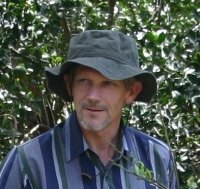Saturday, October 25, 2008
Entebbe again
* Black-winged stilt (Himantopus himantopus) -- surely one of the most attractive of waders
* African jacana (Actophilornis africanus) -- common, but another visually stunning species
* Long-toed lapwing (Vanellus crassirostris) -- these were out in force
* Gull-billed tern (Sterna nilotica)
* Eurasian hobby (Falco subbuteo)
* African fish eagle (Haliaeetus vocifer) -- fine view of one in juvenile plumage
* African pied hornbill (Tockus fasciatus)
* White-throated bee-eater (Merops albicollis)
* Yellow wagtail (Motacilla flava)
* Black-and-white shrike-flycatcher (Bias musicus)
* Grey-backed fiscal (Lanius excubitoroides)
* Black-headed gonolek (Laniarius erythrogaster)
* Splendid starling (Lamprotornis splendidus)
* Vieillot's black weaver (Ploceus nigerrimus)
* Black-crowned waxbill (Estrilda nonnula)
* Black-and-white mannikin (Lonchura bicolor)
* Pin-tailed whydah (Vidua macroura)
* And sunbirds: Olive-bellied (Cinnyris chloropygia), Green-throated (Chalcomitra rubescens), Scarlet-chested (Chalcomitra senegalensis), and Collared (Hedydipna collaris)
A few other sightings of interest in the past several days:
* Common kestrel (Falco tinnunculus) -- in the vicinity of multi-storey building in central Kampala city
* Long-crested eagle (Lophaetus occipitalis) -- over our house
* African little sparrowhawk (Accipiter minullus) -- a pair crossing between trees just outside our compound
* Double-toothed barbet (Lybius bidentatus) -- in Kampala city
* Ross's turaco (Musophaga rossae) -- in our neighborhood
Tuesday, October 21, 2008
More BOPs
But the feature attraction, for me, was the varied collection of birds of prey that came through. There had been some thunderstorms in the area, and there were also flights of breeding termites ascending, so conditions were especially conducive for any migrants in the neighborhood to steer a course through our neck of the woods.
* A number of common (steppe) buzzards (Buteo buteo)
* Several shikras (little banded goshawk -- Accipiter badius) -- not migrants, but out chasing the winged termites
* Several falcons, including a few European hobbies (F. subbuteo) and some possible lesser kestrels (F. naumanni)
* Two light-colored harriers that looked more like male Montagu's harriers (Circus pygargus) than anything else; they were certainly either Montagu's or pallid harriers (Circus macrourus)
We also had plenty of African black kites (Milvus migrans) around, as well as lizard buzzards (Kaupifalco monogrammicus) and a hooded vulture (Necrosyrtes monachus) or two.
Wednesday, October 15, 2008
B.O.P.s
A few days back a large falcon passed by, too quickly for positive ID, but odds are that it was a lanner (F. biarmicus).
Yesterday we had a couple of migrating common (steppe) buzzards (Buteo buteo) overhead.
And this morning while we were at breakfast, the distinctive display call of the male African goshawk came in through the window from obviously close quarters. We dashed over to have a look, and sure enough, there he was, perched in bright sunlight only 20 meters or so from us on a branch of one of our musizi trees (Maesops emini). I grabbed binoculars and had an excellent look at him before he departed his post under pressure from some pied crows (Corvus albus) that were harrassing him.
Monday, October 6, 2008
Morning bishops and sunbirds
Sunbirds I came across included olive-bellied (Nectarinia chloropygia), scarlet-chested (Nectarinia senegalensis), bronze (Nectarinia kilimensis), marico (Nectarinia mariquensis) and little purple-banded (Nectarinia bifasciata). Had particularly fine views of male bronze and marico sunbirds working their way up Leonotis stems as they breakfasted on nectar from the tubular orange flowers. Marico and little purple-banded can be difficult to distinguish from each other, and I have seldom if ever before seen both species on one outing.
Our principal bishop species here in town is the black bishop (Euplectes gierowii), and during breeding season it's not unusual to come across a male decked out in regal red, yellow and black, displaying in an area with long grass and shrubs. This morning I was surprised to see at least four and possibly six different males in full nuptial splendor, all in a fairly small area. I also noticed at female or two and some juveniles, evidence of some reproductive success this season.
Other highlights:
* Wire-tailed swallow (Hirundo smithii) collecting mud from a puddle margin for nest-building
* African green pigeon (Treron calva), a pair in a musasa (Sapium ellipticum) tree, one of them on a nest
* In the canary category, both African citril (Serinus citrinelloides) and yellow-fronted canary (Serinus mozambicus)
* Shrikes: brown-crowned tchagra (Tchagra australis) -- am used to encountering them outside of town, but this was the first instance for me in our neighborhood) -- and northern puffback (Dryoscopus gambensis)
* Red-faced cisticola (Cisticola erythrops)
* African blue flycatcher (Elminia longicauda)
* The African black kites (Milvus migrans) are back in force after their seasonal absence, and I also saw some of the first bronze-tailed starlings (Lamprotornis chalcurus) back in this area from their annual intra-Africa migration. If the bronze-tails return to roosting in the Markhamia and adjoining trees on the north side of our house as they did last year, our evenings and early mornings are about to become noticeably noisier!
